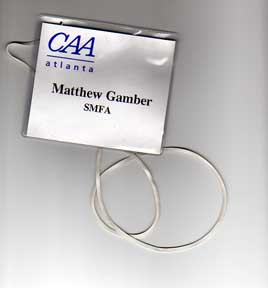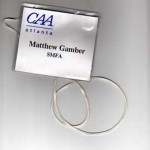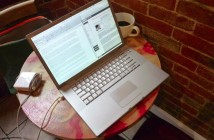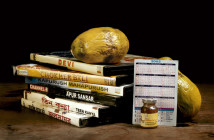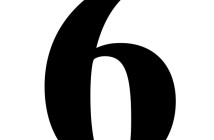I have had the opportunity, in close proximity, to be on both sides of the application process. If you've read though parts of Issue 35, and you are unfazed by the articles on Art and Academia, here are some tips for the potentially employed attending the career fair at the College Art Association's 94th Annual Conference in Boston this upcoming week. This letter is primarily directed to job seekers, not recreational conference attendees.
Differences between Membership and Registration
If you already have your CAA membership card, proceed into the Candidate Center to view the jobs (if you haven't already online) and then to the interviewer tables to drop off your packages. If you did not sign up to be a member or have not received your membership card, you must obtain one at the registration area. You must present your membership card to the guard - you need to get it first.
You do not need to register for the conference (This may be folklore, but it is worth it to try. I did not - see right*). Depending on what line you are in, it may happen in the same transaction to get the card and to register for the conference. Request only the membership card, though they may say you need the name badge. Words may become heated or misunderstood . The badge allows you access to book fair, lectures, lectures, presentations, special sessions, and some parties. If you can do without these, grab your wallet and back off.
Downside: Potentially less networking options and you don't get to look at some newly published books. Though, if your only goal is to get a job through the Job Fair, you will not have time, or will be too tired, to attend any extra curricular events. Make your own name tag. Those of you that are visiting, go spend your $240 on the town - you are in a cultural hub. Go see some galleries.
Slide and Resume Packages
In the Candidate Center, there will be computers with an internet hookup. Look on your membership ID card - you need this number to sign onto the Online Career Center. You can post a resume (don't rely on it, not every school will look at an electronic version) and look at which schools are attending the conference. You've got five minutes on the timer. Keep organized, do one thing during that time. If you need to print something or change a document do that first, check your messages later. This also gives you an opportunity to quickly learn something about the college you now have an interview with, but didn't know about, having just dropped off package on a whim.
Instead of giving out a nonspecific, stock cover letter, you can customize it for each school, (it won't make or break your package, but it's a nice touch). Bring a flash drive, and/or a CD that has your cover letter and resume, maybe some sample syllabi (or email them to yourself). Fill your cover letter with direct, specific information that is presented appropriately. Don't make it more than a page, or fill it full of superlatives in a passive voice that ingratiates you to the school. Make them want you. Keep some dignity, don't drool. Also, take out the phrase: "... I am responding to your listing with the College Art Association, etc." They know where you saw it, and when - perhaps five minutes ago.
Customize your package for each school. Give them what they asked from you. Don't put in a whole photocopied book of student evaluations unless solicited. Have your essentials of everything you might need in folders and then tailor your package to the school with the information they request. This is more effective than gutting pre-made packages.
Also, keep the design simple and consistent. You want schools to understand the information on your resume, they don't want to interpret it. Don't use crazy fonts to show how artful you are. You are at the conference and "art" is in the name of it - it's understood already. Put your name, phone number, and address on EVERYTHING.
The main object of the application package: prove you can organize along some simple guidelines.
Slides or CD's?
Not computer savvy? Not to worry, slides are still the staple diet. Don't expect them to be projected, so the neatness of the slides can count. Avoid handwriting on them unless you took a drafting class, or went to school when penmanship was a still a virtue. Get some Avery return address labels and print out your slide information. If the slides are crooked, bang them out or remount them in Gepe mounts - they snap together and you can reset them. Also, you can use this opportunity to mask them if you can still see the homasote board behind your art. Make sure they are exposed correctly and it represents your work close enough that you can recognize it. If what I said hasn't made any sense - pay someone else to shoot your slides. Don't forget the student work!
CD's give you a chance to show your ability to embrace the future of technology. However, make sure that all of your images are jpegs and they are saved at the same size at 72 dpi. This will ensure they can be opened on most computers. Don't upscale tiny pictures, always downscale from larger files. PowerPoint is probably okay, but don't count on it. An integrated, clickable Flash projector for your images is best - one CD formatted for Mac, the other for PC.
With extra storage, there is a desire to pack the CD full of work. Keep your work to twenty, like the slides - and don't write on it with a Sharpie. Again, print out some labels and keep the design consistent. Don't forget to put paper copies of your resume, artist statement, philosophy, etc. in the package. But, if you want put an artist statement and a resume on the disk, save it as a PDF and not an obscure. cwk or .txt file.
WARNING: Don't expect your perspective employers to have a web access or even computer available (If you have a website DO NOT use it as your only image source). If possible, make an inkjet, digital contact sheet that replicates the look of a traditional slide page. Also, test your CD on several computers to be sure that opens. Otherwise, your beautiful, luminous work remain undiscovered due to an inoperative, 50¢ piece of dye impregnated plastic. Want foolproof? Get digital slides made of the same files you will include on the CD.
The Interview
Get a cell phone and put that number on everything along with your name (otherwise, you'll be checking phone messages from a pay phone). Your interviewers will probably be calling you on one, if they haven't left you an email. Some still use the Message Center, which is a board to pin handwritten notes, under the first initial of the candidate's last name. It's not used like it was in the past, but check them every so often.
Show up mildly early, and don't hover at the table (or hotel room). There will be chairs somewhere, you can calm down after rushing around so you can stop sweating. Relax just enough so that you don't talk incessantly, but not so much that say "screw" during your interview, just to be flip.
Don't be a personality by your appearance, dress conservatively. Interviewers are doing their job for the college they represent. Though they may be artists at the core, your interviewers are not accessing that part of their brain. They are not in a mindset to appreciate your artful performance or dazzling costume. Think funeral, it is a somber occasion filled with sociable conventions that are subject to faux pas. If you have a hotel room nearby, you can change out of your Chucks, if necessary. If you live in town, go home and iron some clothes.
Rejection
If you've done the math, you know that your rejection rate will be substantially higher than success rate. Don't take any rejection too personally. There are many qualified people seeking out the same positions (sorry if you are the jealous type or one of them happens to be your friend or your partner). There are also many extenuating circumstances why your application might have been rejected. With that said, don't emotionally beat yourself up or become paranoid. It just wasn't a good fit, for whatever reason.
Change your perspective - you should give out every package you have. The fact that you are rejected so many times means you've done what you came to do. Also, put a positive spin on a rejection - you just got set of slides back. This is your opportunity to go back and hand them out again.
College Art Association
MBTA - Subway Map

